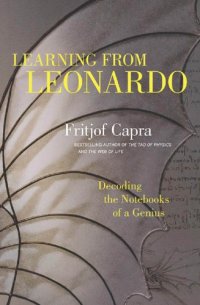
Ebook: Learning from Leonardo: decoding the notebooks of a genius
Author: da Vinci Leonardo, Capra Fritjof
- Tags: HISTORY--Renaissance, Naturwissenschaften, SCIENCE--History, SCIENCE--Philosophy & Social Aspects, Science Renaissance, Creative ability in science, Discoveries in science, Notebooks, Biography, Notebooks sketchbooks etc, Leonardo -- da Vinci -- 1452-1519 -- Notebooks sketchbooks etc, Leonardo -- da Vinci -- 1452-1519, Leonardo -- da Vinci -- 1452-1519, SCIENCE -- Philosophy & Social Aspects, SCIENCE -- History, HISTORY -- Renaissance
- Series: BK currents book
- Year: 2014
- Publisher: Bk
- City: San Francisco
- Edition: First edition
- Language: English
- pdf
Prologue: Leonardo's genius -- I. Form and Transformation in the Macrocosm: 1. The movements of water; 2. The living earth; 3. The growth of plants -- II. Form and Transformation in the Human Body: 4. The human figure; 5. The elements of mechanics; 6. The body in motion; 7. The science of flight; 8. The mystery of life; Coda: Leonardo's legacy -- Chronology of Leonardo's life and work -- Leonardo's notebooks: Facsimiles and Transcriptions -- Resources for Leonardo scholarship.;"Bestselling and world-renowned author Fritjof Capra presents the first in-depth and full description of Leonardo da Vinci's amazing scientific work and discoveries in geology, anatomy, flight, mechanics, botany, and fluid dynamics. And Capra reveals what readers can learn for their own lives and work from ten characteristics of Leonardo's genius"--;"Leonardo da Vinci was a brilliant artist, scientist, engineer, mathematician, architect, inventor, writer, and even musician--the archetypal Renaissance man. But he was also, Fritjof Capra argues, a profoundly modern man. Not only did Leonardo invent the empirical scientific method over a century before Galileo and Francis Bacon, but Capra's decade-long study of Leonardo's fabled notebooks reveal him as a systems thinker centuries before the term was coined. He believed the key to truly understanding the world was in perceiving the connections between phenomena and the larger patterns formed by those relationships. This is precisely the kind of holistic approach the complex problems we face today demand. Capra describes seven defining characteristics of Leonardo da Vinci's genius and includes a list of over forty discoveries Leonardo made that weren't rediscovered until centuries later. Leonardo pioneered entire fields--fluid dynamics, theoretical botany, aerodynamics, embryology. Capra's overview of Leonardo's thought follows the organizational scheme Leonardo himself intended to use if he ever published his notebooks. So in a sense, this is Leonardo's science as he himself would have presented it. Leonardo da Vinci saw the world as a dynamic, integrated whole, so he always applied concepts from one area to illuminate problems in another. For example, his studies of the movement of water informed his ideas about how landscapes are shaped, how sap rises in plants, how air moves over a bird's wing, and how blood flows in the human body. His observations of nature enhanced his art, his drawings were integral to his scientific studies, and he brought art and science together in his extraordinarily beautiful and elegant mechanical and architectural designs. Obviously, we can't all be geniuses on the scale of Leonardo da Vinci. But by exploring the mind of the preeminent Renaissance genius, we can gain profound insights into how best to address the challenges of the 21st century"--
Download the book Learning from Leonardo: decoding the notebooks of a genius for free or read online
Continue reading on any device:

Last viewed books
Related books
{related-news}
Comments (0)